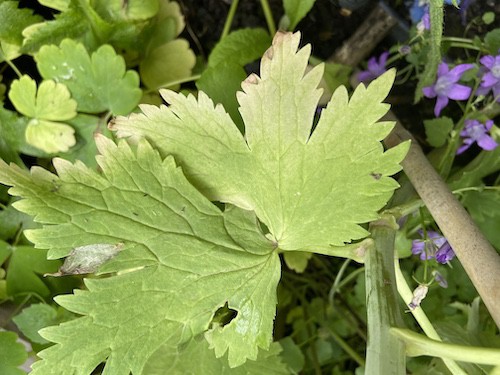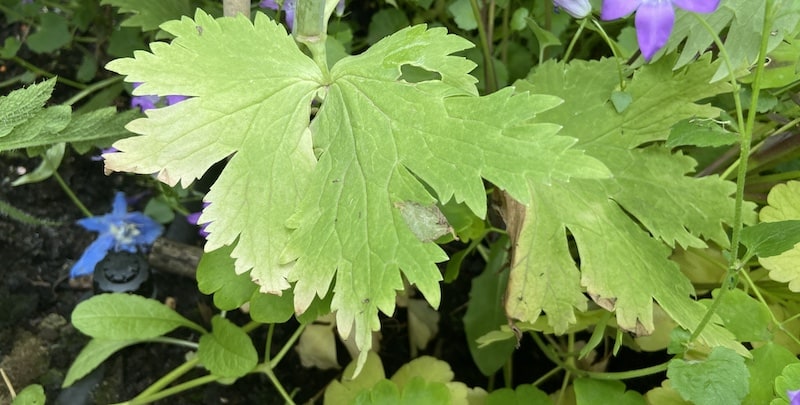Have you ever noticed your delphinium leaves turning yellow and wondered why? In this article, we will explore some common reasons behind this color change. Yellowing leaves in delphinium plants can be caused by various factors such as nutrient deficiencies, overwatering, poor drainage, pest infestation, or disease. By understanding the potential causes, we can then take appropriate measures to rectify the issue and ensure our delphiniums thrive with vibrant green foliage. So, let’s dive right in and uncover the reasons behind those yellow delphinium leaves!

Nutritional Deficiencies
Lack of Nitrogen
If you notice that your delphinium leaves are turning yellow, one possible reason could be a lack of nitrogen. Nitrogen is crucial for plant growth and plays a vital role in the production of chlorophyll, which gives leaves their green color. When a plant lacks nitrogen, its older leaves may turn yellow. To remedy this, you can use nitrogen-rich fertilizers or organic amendments such as compost or manure. Make sure to follow the recommended dosage, as too much nitrogen can also harm the plant.
Insufficient Iron
Another potential cause of yellowing delphinium leaves is insufficient iron. Iron is essential for the production of chlorophyll, and when it is lacking, the leaves can become yellow or even white. To address this issue, you can apply iron chelates or iron-rich fertilizers specifically formulated for plants with iron deficiencies. Additionally, ensuring that the soil pH is within the appropriate range for delphiniums (slightly acidic to neutral) can enhance iron availability to the plant.
Phosphorus Deficiency
A deficiency in phosphorus can also lead to yellowing of delphinium leaves. Phosphorus is crucial for energy transfer and growth in plants, and when it is lacking, the leaves may turn yellow or even develop a purple tint. To address this deficiency, you can apply phosphorus-rich fertilizers or organic amendments such as bone meal or rock phosphate. Additionally, maintaining proper soil pH can enhance phosphorus availability.
Overwatering
Waterlogged Soil
Overwatering is a common mistake that many gardeners make, and it can have detrimental effects on delphinium plants. When the soil becomes waterlogged, it limits the amount of oxygen available to the roots, leading to poor nutrient uptake and root damage. As a result, the leaves may turn yellow and the overall health of the plant may deteriorate. To prevent waterlogged soil, ensure that your delphiniums are planted in well-draining soil and only water when the top inch of soil feels dry.
Root Rot
Overwatering can also lead to root rot, a fungal disease that can be fatal to delphiniums. The excessive moisture creates a favorable environment for fungal pathogens to thrive, attacking the roots and impeding their ability to absorb nutrients. As a result, the leaves may turn yellow, wilt, and the plant may eventually die. To prevent root rot, make sure the soil is well-draining, avoid overwatering, and consider using fungicides or natural remedies to treat the disease if it occurs.

Underwatering
Drought Stress
On the other end of the spectrum, underwatering can also cause yellowing of delphinium leaves. When plants experience prolonged periods of drought or receive insufficient water, they enter a state of drought stress. This stress can affect the overall health of the plant and cause the leaves to turn yellow or brown. To prevent drought stress, make sure to water your delphiniums adequately, especially during hot and dry periods. Regularly check the soil moisture level and water when necessary, ensuring the water reaches the root zone.
Pests and Diseases
Powdery Mildew
One of the most common diseases affecting delphiniums is powdery mildew, which can cause yellowing of the leaves. This fungal infection appears as a white or gray powdery coating on the leaves and stems, limiting photosynthesis and nutrient absorption. To control powdery mildew, ensure good air circulation around the plants, avoid overhead watering, and consider using fungicides specifically formulated for powdery mildew.
Leafhoppers
Leafhoppers are tiny insects that feed on plant sap, causing significant damage to delphiniums. Their feeding can lead to yellowing of the leaves, stunted growth, and even death of the plant. To deter leafhoppers, you can introduce beneficial insects such as ladybugs or lacewings, use insecticidal soaps, or apply Neem oil. Regular monitoring and early intervention are key to preventing severe infestations.
Aphids
Aphids are another common pest that can cause yellowing of delphinium leaves. These small, soft-bodied insects feed on the plant sap and excrete a sticky substance known as honeydew, which can attract other pests and promote fungal growth. To control aphids, introduce natural predators like ladybugs or lacewings, spray the affected plants with a strong jet of water to dislodge them, or use insecticidal soaps.
Spider Mites
Spider mites are tiny pests that can infest delphiniums and cause yellowing leaves. These arachnids feed by piercing the plant cells and extracting sap, leading to chlorotic leaves and webbing on the plant’s surface. To control spider mites, regularly mist the plants to increase humidity, remove heavily infested leaves, and consider using insecticidal soaps or horticultural oils.

Environmental Factors
Excessive Heat
Excessive heat can cause stress to delphiniums and result in yellowing of the leaves. When exposed to high temperatures for extended periods, the plant’s ability to absorb nutrients and perform photosynthesis can be compromised. To protect your delphiniums from excessive heat, provide shade during the hottest part of the day, ensure adequate soil moisture, and consider using mulch to regulate soil temperature.
Extreme Cold
Delphiniums are generally frost-tolerant plants, but exposure to extreme cold can still cause yellowing of the leaves. Frost damage can occur when temperatures drop below the plant’s tolerance level, leading to cellular damage and discoloration. To protect your delphiniums from extreme cold, consider covering them with frost blankets or moving container-grown plants indoors during freezing temperatures.
Strong Winds
Strong winds can also be a contributing factor to yellowing delphinium leaves. When plants are exposed to constant strong winds, they can experience physical damage and stress, resulting in yellowing or browning of the leaves. To protect your delphiniums from strong winds, consider using windbreaks or staking the plants for support. Applying a layer of mulch can also help to reduce wind impact on the soil and plant roots.
Improper pH Levels
Acidic Soil
Delphiniums prefer slightly acidic to neutral soil pH. If the soil becomes too acidic, it can negatively affect nutrient availability and lead to yellowing of the leaves. To address acidic soil conditions, you can apply lime or other soil amendments to raise the pH level. Additionally, regular soil testing can help you monitor and adjust the pH as needed to ensure optimal plant health.
Alkaline Soil
Alternatively, if the soil becomes too alkaline, it can also cause yellowing of delphinium leaves. In alkaline soil, certain nutrients become less available to the plants, leading to deficiencies and discoloration. To correct alkaline soil conditions, you can apply elemental sulfur or other soil amendments to lower the pH level. Regular soil testing is key to identify and correct alkaline soil conditions promptly.

Improper Lighting
Insufficient Light
Delphiniums thrive in full sun to partial shade conditions. If they receive insufficient light, the plant’s ability to perform photosynthesis may be compromised, resulting in yellowing of the leaves. To ensure your delphiniums receive enough light, plant them in a location that receives at least six hours of direct sunlight per day. If sunlight is limited, consider using supplemental grow lights to provide adequate light intensity.
Excessive Light
On the other hand, excessive light can also cause yellowing of delphinium leaves. When plants are exposed to intense, direct sunlight for extended periods, they can experience sunburn or heat stress, leading to leaf discoloration. To protect your delphiniums from excessive light, provide partial shade during the hottest part of the day or use shade cloths to filter sunlight intensity.
Root Issues
Root Rot
As mentioned previously under the overwatering section, root rot can occur when the roots are continually exposed to excessive moisture. The presence of root rot can lead to yellowing of delphinium leaves, as the roots are no longer able to absorb nutrients effectively. To prevent root rot, ensure proper drainage and avoid overwatering. If root rot develops, it may be necessary to remove the affected plant parts and treat the remaining plant with fungicides.
Root-bound Plant
Another common root issue is when a delphinium becomes root-bound. This occurs when the plant has outgrown its container or if the roots have become densely intertwined within the soil. A root-bound plant may exhibit yellowing leaves, stunted growth, and limited nutrient uptake. To address this issue, consider repotting the plant into a larger container or gently loosening the roots before transplanting into the ground. Properly spacing plants during planting can also help prevent root binding.
Fungal Infections
Botrytis Blight
Botrytis blight, also known as gray mold, is a fungal infection that can affect delphiniums. This disease is characterized by grayish-brown fuzzy growth on the leaves, flowers, and stems, leading to the development of yellow or brown spots. To prevent botrytis blight, ensure good air circulation around the plants and avoid overhead watering. If the infection occurs, promptly remove and dispose of the affected plant parts and consider using fungicides as recommended.
Chemical Damage
Herbicide Exposure
Accidental herbicide exposure can cause yellowing and damage to delphinium leaves. Herbicides containing chemicals like glyphosate can drift in the wind or seep into the soil, affecting neighboring plants and causing leaf discoloration. To prevent herbicide damage, follow label instructions carefully when applying herbicides and be mindful of nearby delphiniums. If damage occurs, remove the affected leaves and rinse the plant thoroughly with water to minimize further exposure.
Final Thoughts
Yellowing delphinium leaves can stem from a variety of causes, ranging from nutritional deficiencies and improper watering to pests, diseases, environmental factors, and chemical damage. Identifying the specific cause is crucial in order to implement proper remedies and restore the plant’s health. By addressing these issues promptly and providing optimal growing conditions, you can ensure vibrant and healthy delphiniums in your garden.

About Author
Skyler Day is a dedicated garden enthusiast who finds joy in all things related to planting and gardening. With a green thumb and a wealth of knowledge about plants and gardening techniques, she loves to share her tips and tricks with fellow enthusiasts. When she’s not in the garden, she enjoys hiking and exploring the great outdoors.
